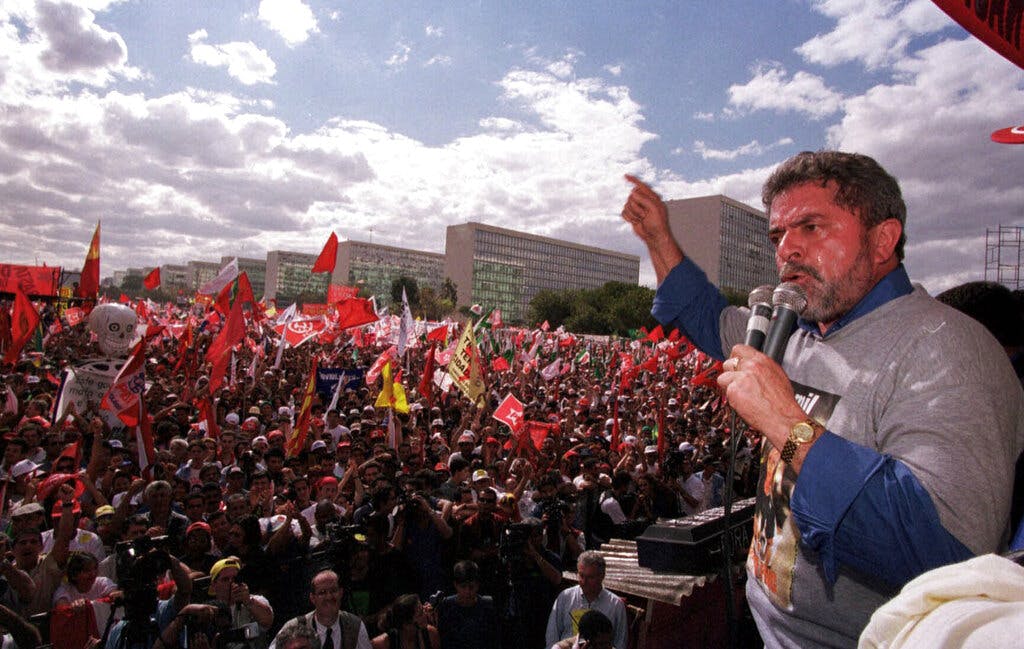Brazil’s Leftward Shift Adds Urgency to U.S.-China Competition in Region
President Biden was quick to congratulate Lula da Silva for his narrow election victory — but so did the newly re-crowned Beijing strongman. Leftist Latin leaders may opt for neutrality, but doing so increasingly could become difficult.

Communist China, long eager to dominate the Western Hemisphere, may find the going easier now that the Latin American left has completed its sweep of the region’s politics with Brazil’s election of Lula da Silva Sunday.
After being relegated to the back pages of Washington’s foreign policy briefs for some time, Latin America now stands to emerge as a top arena where America and China compete for influence. Leftist Latin leaders may opt for neutrality, but doing so increasingly could become difficult.
In Latin America, “our number one pacing threat is the People’s Republic of China,” the commander of the United States Southern Command, General Laura J. Richardson, told Congress in March. In a statement, she added that Russia, terrorist organizations, and Iran are secondary threats.
President Biden was quick to congratulate Mr. da Silva for his narrow election victory — but so did the newly re-crowned Beijing strongman, Xi Jinping.
“I am willing to work with President-elect Lula, from a strategic and long-term perspective, to jointly plan and promote to a new level the comprehensive strategic partnership between China and Brazil,” Mr. Xi wrote in a statement.
The ideology of Mr. da Silva’s Workers Party is much closer to Mr. Xi’s worldview than that of President Bolsonaro, who often berated Lula’s ties with the Communist country. Mr. da Silva also sees his role as a founding member of the Brazil, Russia, India, and China alliance — known as Brics — as one of the greatest accomplishments of his 2003-2010 presidency.
“China doesn’t buy from Brazil, it is buying Brazil”: That was a top slogan in Mr. Bolsonaro’s victorious 2018 campaign, in which the right winger constantly tied the Workers Party to Beijing. Yet, months into his presidency, in October 2019, Mr. Bolsonaro traveled to Beijing, where he said that China “doesn’t even look like a communist country,” and invited Chinese investors to Brazil.
In reality, Brazil is too closely tied to China, its biggest trading partner, to turn its back on Beijing — which explains how “a pro-Xi candidate lost to another pro-Xi candidate,” a long-time Latin America observer told the Sun.
In 2021, Brazilian exports to China amounted to $41 billion, making it the Communsit behemoth’s largest supplier of agricultural produce, accounting for 20 percent of such imports. In the last decade, nearly a half of Beijing’s predatory Silk and Road projects in Latin America were in Brazil, where it invested $66 billion.
Like most other countries in the hemisphere, Brazil nevertheless keeps close ties with America as well. “They all want to maintain good relations with Washington and Beijing,” a Latin American studies professor at New York University, Jorge Castaneda, told the Sun, adding, “they call it non-alignment.”
Mr. Castaneda, who was Mexico’s foreign minister in the early 2000s, notes that currently trade between China and Mexico, along with Central American and Caribbean countries, is much less extensive than Beijing’s ties with South America.
While Washington has long put Europe, the Mideast, and Asia at the top of its agenda, America nevertheless remains a major power in the hemisphere. Neighbors are bound by the North American Free Trade Agreement, repackaged by President Trump as USMCA. Free-trade agreements with Chile, Colombia, and Peru, as well as extensive ties with many others, keep Washington relevant. Argentina clamors for loans from the American-dominated International Monetary Fund.
Yet, as General Richardson noted in her report to Congress, Communist China is making serious inroads.
A Beijing-run space research facility at Neuquén, Argentina, “could track and target U.S. satellites,” the general warned, adding that a Chinese company’s installation in the Argentine port of Ushuaia “could provide Beijing with a presence at the Strait of Magellan and improve access to Antarctica.”
A Chinese operator runs El Salvador’s La Union port, a $3 billion project that is “strategically located at the intersection of Salvadoran, Honduran, and Nicaraguan territory,” General Richardson wrote. Latin countries are increasingly adopting Huawei’s 5G technology, and many purchase Chinese Covid vaccines, despite their shortcomings in fighting the disease.
Beijing flies Latin American military personnel to China, where they learn military doctrine in a scheme “modeled after U.S. professional military education programs,” General Richardson wrote. They also receive training in Mandarin and cybersecurity. China sells arms and “gifts” supplies and telecommunications equipment to “gain access and win favor with regional security forces.”
At the height of last century’s Cold War, in the 1950s, a bloc of countries formed the Non-Aligned Movement, which by the 1970s became solely aligned with the Soviets. In today’s sequel, as Beijing strives to replace America’s liberal model with Mr. Xi’s brand of nationalist Communism, non-alignment may similarly be difficult to maintain.
Washington would be wise to zero in on its backyard, where a faraway and hostile power is striving to imitate James Monroe’s famous doctrine.

